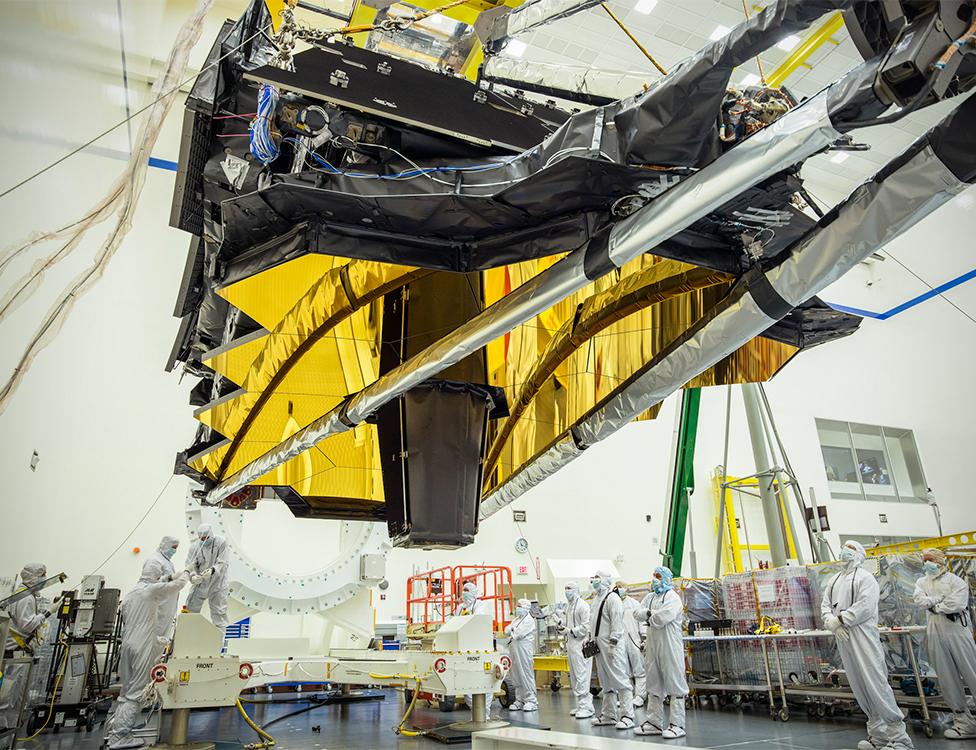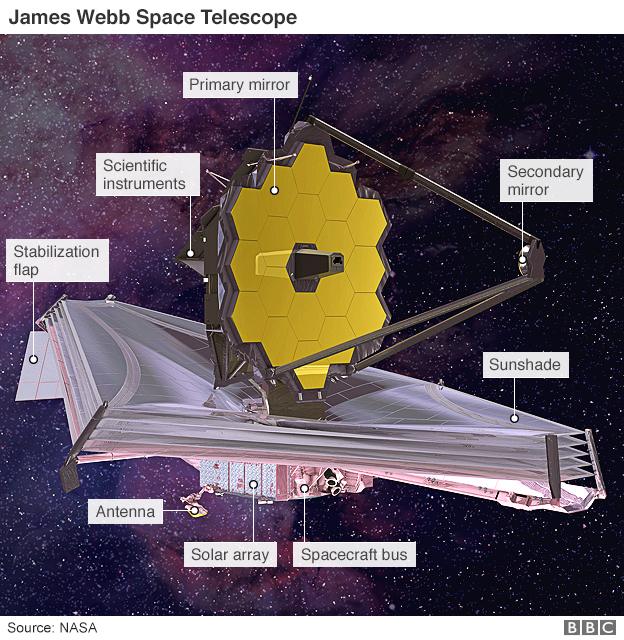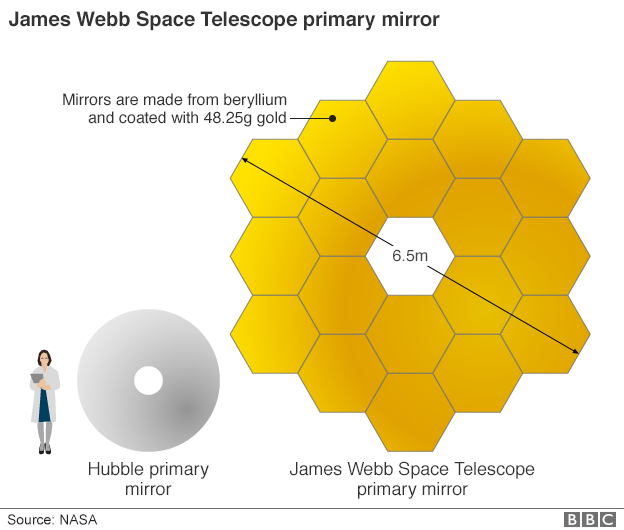JWST: Launch of Hubble's successor pushed back to 2021
- Published

Webb contains novel technologies that have never previously been flown in space
The successor to the Hubble observatory will not now launch until 30 March 2021 at the earliest.
The 29-month delay, from October this year, follows a review into the technical challenges currently facing the James Webb Space Telescope (JWST), external.
The date change and the extra work required pushes the likely cost of the project to $9.66bn (£7.27bn).
JWST will use a huge mirror and state-of-the-art instruments to try to see the first stars to shine in the cosmos.
It will have the power as well to resolve the atmospheres of some of the new planets being discovered beyond our Solar System, and to analyse their atmospheres for the potential for life.
The US space agency has expressed frustration at the latest setback. However, its science director, Thomas Zurbuchen, argued that "Webb would be worth the wait".
"By setting this new launch date, Nasa agrees with the central findings of the Independent Review Board, external (IRB) that the development of the telescope should move forward because of the exceptional potential that it has and the spectacular science that will be returned when Webb is out there in space."

What's so special about JWST?
The Hubble space telescope launched in 1990 and transformed our view of the cosmos. But the veteran observatory is restricted in how deep into the Universe it can see, and by extension how far back in time it can probe.
Hubble cannot quite detect the light coming from the ignition of the very first population of stars more than 13 billion years ago. JWST in contrast has a 6.5m-wide mirror - seven times the light-collecting area of Hubble - and instruments that are perfectly tuned in the infrared to pick up the light from these founding stars.
Just how big is the new delay?
JWST's problems go way back. Even as Hubble was being launched in 1990, scientists were planning what would come after. Before being officially approved, the Next Generation Space Telescope, as it was known back then, was thought likely to cost from $1bn to $3.5bn. Launch dates ranging from 2007 to 2011 were considered realistic. They were all hopelessly optimistic.
The whole mission was re-profiled in 2011, with a target launch date set for October 2018 and a cost ceiling imposed of $8.8bn. But this new plan also foundered, and Webb's launch was again pushed back, first to between March and June 2019, then to May 2020, and now to early 2021.
Why has it been so difficult?
The re-profiling of the mission in 2011 addressed many embedded problems in the project. What was under-appreciated was just how long it would take to integrate and test all of Webb's components - many of them completely novel and never flown in space before.
But on top of that, the new Independent Review Panel has highlighted some simple human errors that have had considerable impact on the schedule. These include applying the wrong solvent to clean the valves on the thrusters Webb will use to position itself in space. These valves have had to be replaced.
Fasteners that will hold covers for the giant shade Webb intends to use to shield its delicate observations were not attached properly in testing. Some bolts came lose and fell into the spacecraft. Some of this hardware is still missing.

Can James Webb make March 2021?
The IRB gives the new projected launch date an 80% confidence rating. It assumes, however, that everything runs smoothly from now onwards in the final integration and testing phases. If similar errors are repeated then the schedule will have to be re-visited once more.
"JWST is an observatory of incredible capability, awesome scientific potential and significant complexity," said IRB chair Tom Young. "The complexity and risk cannot be overstated. The March 2021 launch date assumes the successful implementation of the recommendations in our report. No allowance has been made for additional integration and testing errors and problems with multi-month impacts."
It is worth noting that the revised costing breaches a limit imposed by the American Congress in 2011. As a result, Nasa has to go back to The Hill and get the mission re-authorised. It is highly unlikely that politicians would move to cancel Webb but there are bound to be some strong words of criticism.
It is also worth recognising that the $9.66bn is not the full cost of JWST. This figure covers just the development, build and operation (for five years) in space of Webb on the US side. Europe and Canada have contributed Instruments, and Europe, also, is providing the launch rocket. The value of this partnership probably adds another $0.5bn to the ticket price of JWST.
"The moment I got the IRB report I took a plane to Europe and met with my counterpart at the European Space Agency and we talked through the implications of some of the recommendations that involve both of us," said Dr Zurbuchen.
"I did a similar meeting with Canada thereafter. And you should know that we will go forward together as a team," he told BBC News.
Jonathan.Amos-INTERNET@bbc.co.uk, external and follow me on Twitter: @BBCAmos, external